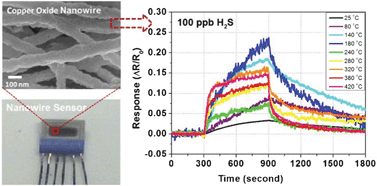Highly sensitive H2S sensor based on template-synthesized CuOnanowires
Abstract
A sensor device featuring massive aligned

* Corresponding authors
a
Department of Chemical Engineering, University of Massachusetts-Lowell, Massachusetts, United States
E-mail:
Zhiyong_Gu@uml.edu
Fax: +01 978 934 3047
Tel: +01 978 934 3540
b Department of Chemical, Materials and Biomolecular Engineering, University of Connecticut, Storrs, Connecticut, United States
A sensor device featuring massive aligned

 Please wait while we load your content...
Something went wrong. Try again?
Please wait while we load your content...
Something went wrong. Try again?
X. Li, Y. Wang, Y. Lei and Z. Gu, RSC Adv., 2012, 2, 2302 DOI: 10.1039/C2RA00718E
To request permission to reproduce material from this article, please go to the Copyright Clearance Center request page.
If you are an author contributing to an RSC publication, you do not need to request permission provided correct acknowledgement is given.
If you are the author of this article, you do not need to request permission to reproduce figures and diagrams provided correct acknowledgement is given. If you want to reproduce the whole article in a third-party publication (excluding your thesis/dissertation for which permission is not required) please go to the Copyright Clearance Center request page.
Read more about how to correctly acknowledge RSC content.
 Fetching data from CrossRef.
Fetching data from CrossRef.
This may take some time to load.
Loading related content
